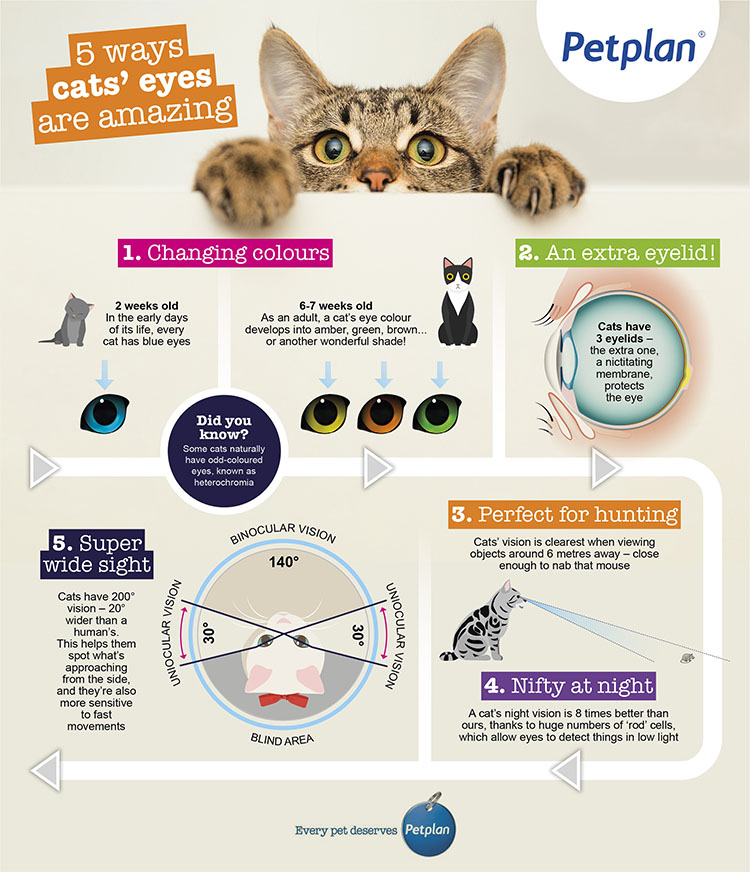Your cat’s eyes are amazing! Here’s how to help keep their vision in tip-top condition and tackle some common feline eye issues.
Cats have excellent powers of vision, and there’s lots you can do to make sure their eyes stay as healthy as possible. This includes watching out for the early-warning signs of eye conditions.
Here, we look at how to check your cat’s eye health, how to clean their eyes if necessary and how to spot the symptoms of the most common cat eye problems. Plus, don’t miss our fun fact sheet on your cat’s amazing eyes!
Cat eye health checks
It’s a good idea to get into the habit of checking your cat’s eyes at least once a week. Make sure their eyes look clean and bright, with equal-sized black pupils. Remember that the size of your cat’s pupils will vary depending on the light conditions. The very outer area of your cat’s eyeball should be white, and their iris (the coloured area) should look even-coloured, with no changes in colour once your cat reaches adulthood.
Cat eye problems to look out for
If you notice any of the following issues, it’s best to book an appointment with your vet:
- Excessive discharge
- Excessive tear production
- Closed, squinting or swollen eyes
- Cloudiness or any change in adult eye colour
- Visible third eyelid (a membrane in the corner of their eye)
- Pawing at the eye or other signs of discomfort
Cleaning your cat’s eyes
Sometimes, cats will get a little dirt or discharge build-up inside the inner corner of their eyes. Cleaning this away occasionally can help your cat feel more comfortable. You can do this using a cotton wool ball dipped in cooled boiled water.
Gently wipe the damp cotton wool ball across your cat’s closed eye from the inner corner out. Use a new cotton wool ball for each eye, to avoid transferring any bacteria. It’s also important to take care that your cat’s eyes are shut while you do this, as otherwise you may scratch the transparent cornea covering their eye.
Handling your cat
Some cats do not enjoy having their eyes checked! Training your cat to calmly accept being handled regularly can make things much less stressful, especially if you do need to visit the vet at any point. Get your cat used to having a head-to-tail check-up in the comfort of your home, and offer them lots of praise and treats as you do so.
If your cat ever needs eye drops, ask your vet to show you how to use these. Having an extra helper to hold your cat as you administer the eye drops can also make things much easier once you’re home. Make sure you read the instructions carefully so you know how many drops to administer, how often and to which eye. It’s sometimes easiest to wrap your cat in a blanket or towel while doing this, so only their head is exposed. The most important thing is to keep the experience as stress-free as possible, so again, be sure to talk to them calmly and reassuringly, praise them for being good, and reward them with a favourite treat.

Common cat eye problems
We’ve outlined some of the most common eye conditions found in cats. If you’re ever concerned about your cat’s eyes, it’s always best to seek the advice of your vet as soon as possible.
Conjunctivitis
Also known as pink eye, this condition creates inflammation over the inner eyelid or outer layers of the eye. It’s one of the most common eye problems for cats and is often caused by viral infection, although it can also be caused by bacteria, allergens and foreign bodies.
Symptoms
- Redness
- Swelling
- Discharge
- Squinting
- Irritation and pawing at the eyes
Treatment
The treatment your vet recommends will depend on what caused your cat’s conjunctivitis. If your cat’s conjunctivitis is bacterial, your vet may prescribe antibiotics that may be topical, oral or both. For viral infections, antiviral medications are sometimes recommended, but vaccinations can also protect against future infections. Allergic conjunctivitis may be treated with an eye wash or ‘anti-allergy’ medications. Steroidal treatments may also be recommended.
Corneal ulcers
If your cat’s cornea becomes scratched, this can develop into a painful ulcer. Often these ulcers are caused by a laceration from a scratch to the eye, or a foreign body like a grass seed. Corneal ulcers can be difficult to detect, but can rapidly progress.
Symptoms
- Watery eyes
- Excessive discharge
- Blinking more than usual
- Redness
- Pawing at the eye
Treatment
Your vet may use a special stain to detect a corneal ulcer. The treatment will depend on what caused the ulcer, but can include topical antibiotics and anti-inflammatories. Sometimes, surgery will be necessary to debride the cornea and promote healing.
Cataracts
Cataracts can be an inherited condition. Some breeds, including Birman, Persian and Himalayan cats, are predisposed to developing cataracts. Older cats, or those with diabetes, are also more at risk. Other reasons for developing feline cataracts include trauma, inflammation and hypertension.
Symptoms
- Blue-grey cloudiness of the pupil
- Signs of reduced vision including bumping into objects, reluctance to explore and instability
Treatment
The severity of the cataract will determine treatment. Your vet may recommend removing the affected lens, which will reduce your pet’s ability to focus but improve their overall vision. This will require referral to a veterinary ophthalmologist. Cataracts are not painful, but you may need to take extra care of your cat if their vision is impaired.
Glaucoma
Glaucoma occurs when the fluid within the eye cannot drain as normal. As a result, there’s a build-up of pressure, which can cause your cat’s eye to become enlarged. Glaucoma is a condition that can develop as your cat ages. Left untreated, it can cause permanent damage to the optic nerve and retina, potentially resulting in loss of sight.
Symptoms
- Squinting or blinking
- Overly large or small pupils, that are unresponsive to light changes
- Redness
- Cloudiness
- Sticky discharge
- Signs of vision impairment, walking into objects or moving slowly
Treatment
Your vet may prescribe medication to lower the pressure within the eye or, in severe cases, removal of the eye may be necessary.
As independent creatures, cats are often very good at disguising any signs that they’re in pain. Take the time to check your cat’s eyes regularly, and ask your vet for advice if you spot any symptoms that give you cause for concern.
Do all your cat-loving friends know just how amazing cats’ eyes are? Download and share our fun fact sheet on cats’ vision.

Do you think we’re doing a good job? If you do, please vote for us in this year’s Insurance Choice Awards. Plus, you’ll also be entered into a prize draw to win £1,000 (Ts&Cs apply)
